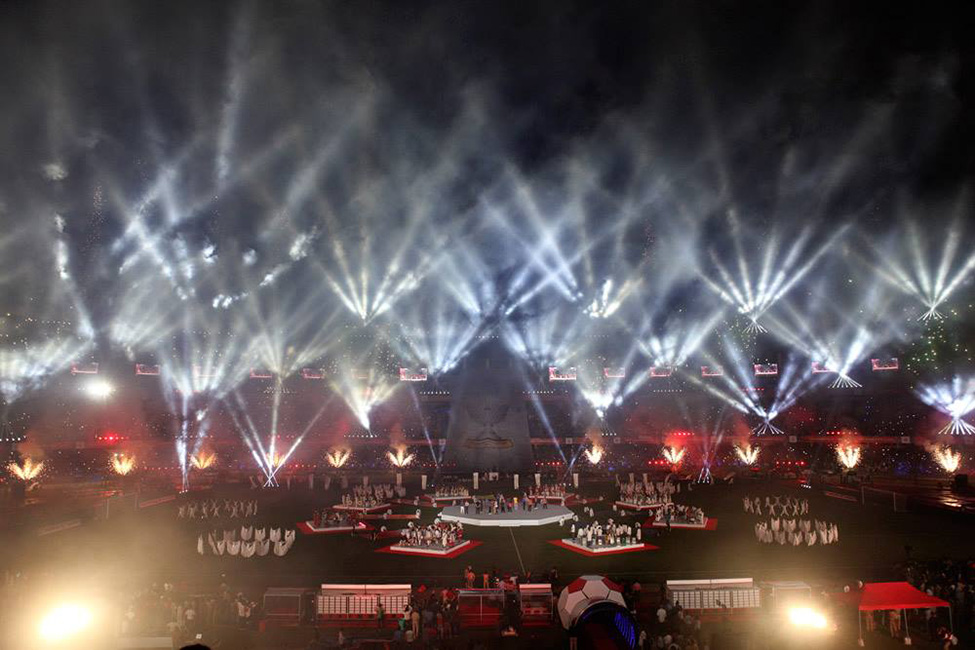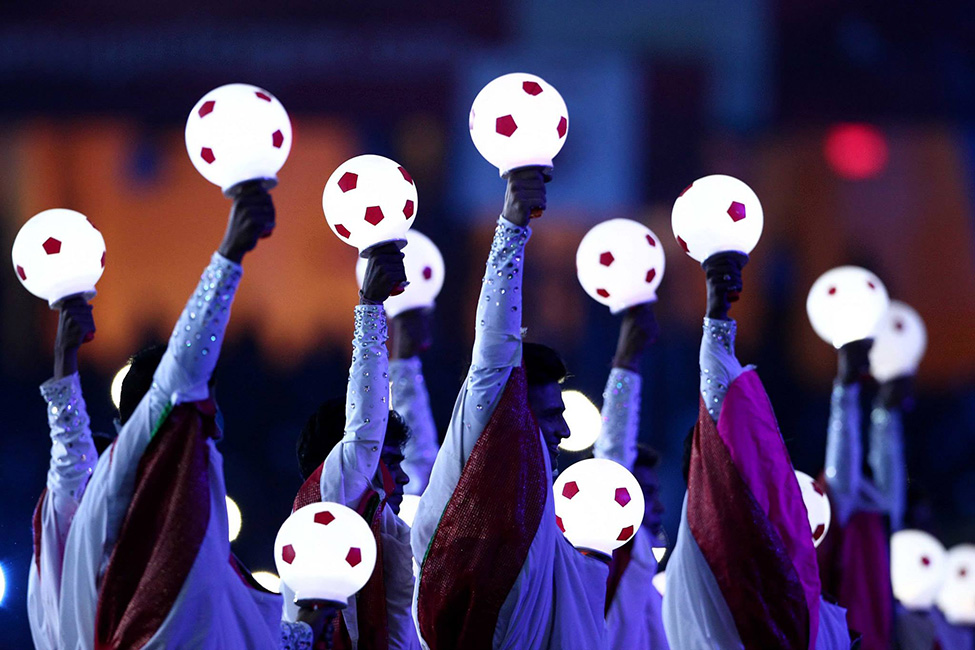The Indian Super League has generated a lot of hype regarding its claim of developing the nation into a potent force in the world of football. 12th October witnessed the start of this tournament amidst a lot of expectations. Soumashish Chakraborty relates his personal experience of being in the stadium and also explores the underlying doubts regarding the extent of the holistic development of the sport …
12 October 2014, Sunday, marked the beginning of an event which is supposed to make a major contribution to India’s chances of improving in the most popular game in the world, football. Many regard it as the primary strategic ploy to conjure up an opportunity for a low -ranked country like ours (FIFA Ranking : 158) to participate in the 2026 FIFA World Cup. It is presumed to happen mainly because of the exposure the Indian footballers will get while playing with/against foreign players who are supposedly better and also in the process, gain valuable football education from foreign coaches. But all of this is mere speculation that surrounds something that is an extract of an older format remodeled and repacked into the visage of another sport. This ‘something’ is the Indian Super League which is, in essence, just another version of the IPL-model with its distinct set of challenges and questions. From the opening ceremony at the Yuva Bharati Krirangan (Salt Lake stadium), Kolkata to the after-match presentation ceremony, the ISL indicates that it will have the same structure that the Indian Premier League was built on. But will the football franchise model be able to match the impact that it’s more popular and proven cousin had? Will it surpass the traditional model of football we have in this country? Or will it be yet another glittering show without much depth and vision to offer?
Last Sunday saw the Salt Lake stadium dressed in the form of a gala event and the impressive line-up of stars and VVIPs was a clear indication as to what the introductory hour before the first game had in store for us. An octagonal center stage with eight smaller rectangles signifying the eight participating franchises which later on staged variant musicians representing their franchises covered most of the area of the pitch. The event began at five in the evening and it didn’t disappoint with its celebratory offers of a beautifully arranged laser light show and live music. Musicians like Shivamani, Bikram Ghosh, Taufiq Qureshi performed on behalf of their franchises while the group dancers performed in rhythm; the colors of their attires changed in accordance with the running music to signify particular geographical locales, in which the eight franchises are situated. West Bengal Chief Minister, Ms. Mamata Banerjee delivered the opening speech after being accompanied to the center stage by Sanjiv Goenka, Vice-Chairman of RPG Enterprises and co-owner of Atletico de Kolkata, Praful Patel, AIFF president and Nita Ambani, Chairperson of IMG-Reliance & founding Chairperson of Football Sports Development. This was followed by a short address by Praful Patel. The host for the evening, Priyanka Chopra took over from there and she introduced the eight franchises in an ordered fashion with one representative from the owner’s side and the other being the team’s marquee player. The drill started with the home side represented by co-owner Sourav Ganguly accompanied by star player and captain Luis Garcia, both of them being greeted expectedly with deafening applauses from the local crowd. The others followed suit with Parineeti Chopra and Alessandro del Piero (Delhi Dynamos) being introduced next. John Abraham and Ricki Herbert (NorthEast United FC) were followed by Dattaraj Salgaocar and Robert Pires (FC Goa). Abhishek Bachchan and Elano Blumer (Chennaiyin FC) came in before Hrithik Roshan and David Trezeguet (FC Pune City) jogged to the stage. Ranbir Kapoor and Fredrik Ljungberg (Mumbai City FC) generated loud cheers primarily because of the Bollywood actor. The introduction of Master Blaster Sachin Tendulkar and David James (Kerala Blasters) proved how Sachin still ruled the hearts of the cricket loving Kolkata fans. The ceremony was wrapped up with firecrackers lighting up the entire stadium for a period that lasted nearly 8 minutes after Nita Ambani officially declared the tournament open.
 The opening ceremony at the Salt Lake stadium (Photo credits:Facebook page of the Hero Indian Super League)
The opening ceremony at the Salt Lake stadium (Photo credits:Facebook page of the Hero Indian Super League)
Till now it was just Bollywoody glittering, starry, and extravagant and IPL-like. Nearly 60,000 people waited patiently to watch how the footballing quotient will unfold . It was the first ISL encounter between the home side Atletico De Kolkata and Mumbai City FC. Between the end of the opening ceremony and the kick off, there was a gap of nearly 45 minutes. In that brief hiatus, I contemplated on a question that Priyanka Chopra asked: whether the noise from the stands was for football or was it for her. It was supposed to be an inane joke but when one critically reflects on the question, there are certain underlying behavioural patterns that come into consciousness. Why did the introduction of Alessandro del Piero and Robert Pires (arguably the two best players to participate in the tournament) not generate enough cheers? Why couldn’t the football crazy crowd of Kolkata greet a prolific striker like David Trezeguet with better conviction? Or why a crucial member of Arsenal’s double winning “invincibles” went nearly unrecognised? Do we actually possess the culture and knowledge to appreciate or criticise what was on offer or is it just the mood-swinging frenzy that will make this tournament a money-generating, capitalistic machine and we will accept it irrespective of the fact whether ISL can actually improve anything related to the material development of football in this country?
While I was in the process of reflecting on all these questions it was time for kick off and the first twenty minutes of the game allowed the doubts to creep in. With the exception of a couple of fine saves from India’s number one custodian Subrata Paul the match hardly had much to offer. Ethiopian striker Fikru Teferra changed the mood with a marvelous chip over the Mumbai City FC goalkeeper after latching on to a delightful through ball from Spaniard Jofre Mateu at the 24th minute of the match which somewhat provided some impetus to the otherwise sluggish encounter. Mumbai City F.C tried to build a few moves but was foiled by the lack of understanding between the players; the home side was clearly better galvanised. Overall the first half didn’t do much to prove the superiority of ISL over its already in place traditional counterparts in terms of quality but one could clearly see that the teams were trying to play according to system.
The second half saw more of the system that put the home side on the ascendancy but the best goal of the game came from a splendid individual effort. Borja Fernandez chested down a lobbed ball off a ricochet and swirled it home through the far corner of the goal. A brilliant out step volley to which India’s no.1 custodian Subrata Paul had no answer. Mumbai tried very hard to come back into the match and they probably would have if not for an alert Subhasish Roy Chowdhury who pulled out a cracker of a save as a half-hearted shot deflected off Atletico De Kolkata center back Josemi was making its way towards the goal. Subrata Paul did have a torrid day but he showed why he was highly rated as he thwarted a header by Baljit Sahni from close range. In the end it turned out to be a comprehensive victory for the Kolkata franchise as they pumped in their third goal late in the second half when Arnal Llibert Conde Carbo tapped in Fikru’s cross after a successful counter attack.
 Players engaged in formal acknowledgement after the first match at the Salt Lake Stadium
Players engaged in formal acknowledgement after the first match at the Salt Lake Stadium
A sense of satisfaction is what the people felt but still the questions were unanswered. It was evident that our players were trying to match up to the foreign players who, presently are not in their prime or are out of favor. But what this connection can do to improve the quality and overall game play of the Indian contingent is still an object of speculation. Can a 2 month long engagement be substantial enough to provide the players what they need to excel in the international scene? There is also this difficult scenario for the Indian players to adapt to a different system quickly as the more traditional I-league is still in business and due to start a few weeks after the end of the first season of the ISL. However if the methods established by the foreign coaches of the eight franchises find acceptance with the local coaches then the players can apply their new discovered education while playing in the I-league as well. Thus both the leagues actually have a chance to grow together. Or will a merger do better? Wim Koevermans who recently stepped down as the coach of India’s national football team during an interview in 2012 stressed that to actually improve and sustain as a squad not only individual skills need to grow but also a system needs to be built around which the players will be assigned roles. The first two matches of the ISL saw a lot of stress on that system where each side tried to gel as a unit and thus both games had fluidity, sensible passing and orchestrated movement, some aspects that the traditional Indian game lacks.
As the tournament unfolds a lot of doubts will be cleared out, answers to a few questions will be revealed but whether it can achieve its main objective will obviously be up for debate even after a few seasons. Questions about its sustainability, global appeal, and quality will get hints after the first season wraps up in December. The ISL is the 6th professional league we have in this country. All the 6 leagues spanned across 6 disciplines of sports have not achieved what they had claimed to. IPL’s success was never in doubt as it was under the banner of cricket, a sport that has been elevated to the level of a religion in the last decade and a half. The recently concluded Pro-Kabaddi league also managed to popularise the sport to some extent but the same cannot be said about the one’s concerning badminton and hockey. Will ISL be able to generate audiences in a cricket crazy nation? Will it be able to satisfy a large part of the population that has unabashed access to the major football leagues in the world? Will it able to get enough attention even in those pockets of the country where football ranks low on people’s list of sporting interests? OR will it simply be attributed as a marketing job? The sudden music at the time of spot kicks and substitutions, the fireworks right when the kick off whistle is blown or a goal is scored proves how desperately the organisers are trying to build a frenzy around the tournament but in sports, spontaneous response is what sustains. Whether the ISL will be blessed with spontaneity or not is there to be seen but the crowd in the first two games in Kolkata and Guwahati did show enthusiasm among the followers. Fans, popularity, media hype, and every other component that are not directly connected to the on-field nitty-gritties of the sport can be created with time but developing, and nurturing talent and transforming them into a force to be reckoned with, will possibly be the biggest challenge of ISL. So we wait for the awakening of Sepp Blatter’s “sleeping giant” of world football.
Photo credits for the featured image: Facebook page of the Hero Indian Super League.














